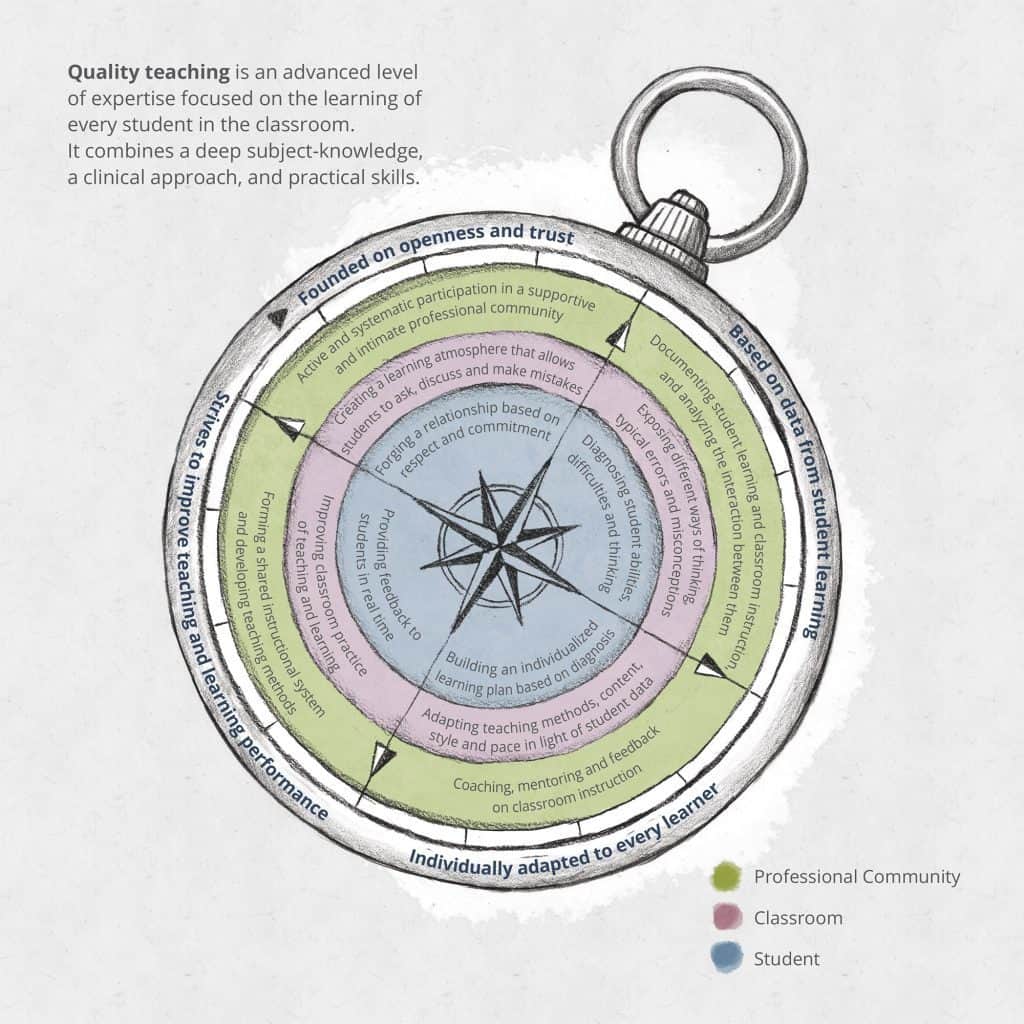High-performing education systems invest primarily in teachers and in their teaching. They decided to do so after numerous failed attempts to improve education by instituting changes outside of the classroom. Their investment in teachers is based on research indicating that the quality of instruction is the most influential factor in the classroom in explaining disparities in student achievement. Learning from their experience, the foundation adopted a similar working assumption which is that there is no bypass route for expanding the circle of excellence in a continuous and sustainable way, without investing in the professional ability of the teaching corps.
We noted that outstanding education systems in Western societies have transformed the teaching occupation from a blue collar production line trade to a clinical knowledge-based specialization, from teaching that is focused on the material to teaching focused on the student. Clinical professions, which are highly attractive, are characterized by a high commitment to each “patient” that includes setting ambitious goals, a personalized program of “treatment,” diagnostics, prognosis, monitoring and feedback. In clinical professions, the practitioner takes an active role in a professional community, routinely consults with colleagues, participates in clinical rounds and residency programs, and is involved in mentoring and coaching.
We believe that quality teaching with clinical characteristics may be of value for every field of study and in all grade levels. However, it plays a special role at the level of excellence in the study of mathematics and science. Since these are abstract fields that are considered difficult to teach and learn, where knowledge and skill are built together, teachers need to instill a learning climate of practice, persistence and, deeper learning, higher order thinking and knowledge transfer. The ability to simultaneously encourage many students to learn, persist and succeed is, therefore, a very challenging mission.

High quality teaching of mathematics and science is based on individual excellence and is methodically and systematically implemented, with careful planning, performance and self-awareness. It is executed in a professional community, with ongoing consultation and a focus on the progress of each and every student. This type of teaching identifies the abilities and difficulties of each student, sets ambitious goals with them, adapts the teaching to the student’s way of thinking and pace of learning, monitors progress and provides the student with constructive and supportive feedback.
Individual excellence of the teacher is a prerequisite for quality teaching. Outstanding teachers come from the top third of university graduates and bring with them in-depth and broad knowledge, as well as solid confidence in the subject matter area and its connection to related fields and to everyday life. They exemplify excellence in their conduct, keep up-to-date with innovations in the field of knowledge, read scientific and pedagogical publications, participate in conferences and seminars, and write, document and publish insights from their work and experience.
Quality teaching in practice is a clinical skill that focuses on providing a personalized solution to each student. It takes place in three arenas of interaction – with the student: the classroom and the community of teachers. It is characterized by reliance on openness, cooperation and trust; continuous diagnosis of the students’ learning; individual adaption of teaching to the abilities, challenges, style and pace of each learner; and by aiming for continuous improvement of teaching and learning performance.
Outstanding teachers:
- Believe and are convinced that all of their students are capable of excelling; demonstrate a profound commitment to making the most of the opportunities that stand before them; set high and attainable individual learning goals with their students; stir their curiosity and help them to become independent learners.
- Create an inclusive and confidence-building learning atmosphere in their classroom that allows for questions and mistakes, encourage the expression of knowledge and opinions in writing and speech, and stimulate intellectual risk-taking. They respect their students, nurture communication skills and creativity, and encourage collaboration.
- Have a practical understanding of how students think and learn the field of knowledge. They comprehend how knowledge develops among students and can identify misconceptions, ways of thinking, learning styles and developmental processes.
- Are proficient in the use of a range of assessment and evaluation techniques, and know how to adapt them to the context in which the learning takes place. They document the learning performance of each student in a comprehensive way and use this in real time to map, diagnose, adapt the teaching and provide constructive and reinforcing feedback.
- Use a wide arsenal of teaching approaches and methods, and exercise sound judgment in choosing strategies and techniques appropriate for the context, the learning topic, the classroom, and the diagnostic findings regarding each student.
- Give their students clear, constructive and supportive feedback in accordance with their learning performance. They choose the type of feedback and the appropriate time to present it, and they use this feedback to help students to internalize the learning goals and become aware of their progress.
- Take an active role in a professional community, which operates regularly under the leadership of master teachers and systematically analyzes classroom learning and teaching.
- Build together the professionalism of teaching, develop a shared instructional system, implement standards of evaluation, create support systems for student learning, and engage in peer learning that includes documentation, analysis, mentoring and feedback.
